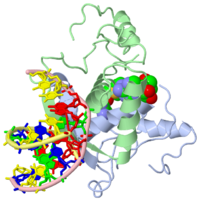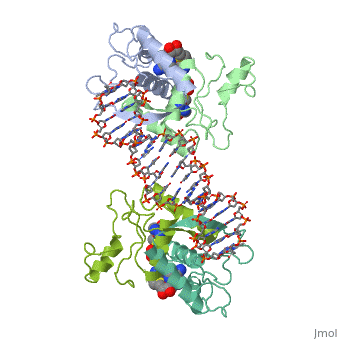Joe Granger Methionine Repressor: Escherichia coli
From Proteopedia
| |||||||||
| Methionine receptor dimer complex with DNA and S-adenosyl methionine 1cma | |||||||||
|---|---|---|---|---|---|---|---|---|---|
| Ligands: | |||||||||
| |||||||||
| |||||||||
| Resources: | FirstGlance, OCA, RCSB, PDBsum | ||||||||
| Coordinates: | save as pdb, mmCIF, xml | ||||||||
Contents |
MET Repressor Behavior and Function
The Met repressor protein is involved with regulating the synthesis of methionine. This protein consists of two 104 amino acid chains and is a homodimer (1). The Met repressor protein forms a complex that works in a manner that is very similar to the Lac operon. (http://www.life.illinois.edu/bio100/lectures/s97lects/16GeneControl/lac_page.html). This repressor, just like in the lac operon binds to a specific operator sequence and halts mRNA transcription. The operator for the Met repressor is the sequence , also called the Met box (3). The operator sequence is the portion of DNA where an activator protein binds. Once bound, an activator can allow for RNAP to attach the promoter region and initiate transcription(4). However, as long as a repressor protein like the Met repressor remains bound to the operator sequence no methionine can be produced. Interestingly, the Met repressor has a very low binding affinity to the met gene’s operator sequence (3). In order to repress the gene, the met repressor needs a co-Repressor molecule. The met repressor’s Co-repressor is S-adenosylmethionine, or . SAM binds non-competitively to the Met repressor. It does not seem to drastically affect the met repressors overall structure, but it does greatly increase the binding affinity of the met repressor to the operator sequence(3). In the presence of methionine, the SAM is knocked off, and the Met repressor leaves the operon allowing for RNAP to bind. This process is very similar to the Lac operon that requires lactose in order to be able to remove repressors and initiate transcription(4).
MET Repressor Structural Characteristics
The structure of the Met repressor is a homodimer consisting of two 104 amino acid chain monomers. The structure of each monomer consists of an N-terminus and a flexible loop made up of the first 20 amino acids. Following that, there is a beta sheet that contains residues 21-28 which is the critical factor in the repressors DNA binding character that is explained later (1). The beta sheets also hold a major role in binding the two monomers together. The beta sheets bind together in an within their own beta sheet, and also to the opposite monomer's beta sheet(2). Also, each monomer has 3 alpha helix domains: residues 30-45, 52-66, and 86-94 (1).
MET Repressor DNA Binding Character
The Met repressor works to bind the DNA operators that activate the transcription of methionine producing genes. The full operator consists of 2 direct repeats of the met box : 5'-TT AGACGTCT AGACGTCT A-3' (3). When this protein is bound to the DNA operator, it prevents RNA polymerase from being able to bind and promote transcription. It achieves this by taking the place of the activators on the operon. The crystal structure of the Met repressor-operator complex shows two dimeric repressor molecules bound to adjacent sites 8 base pairs apart on an 18-base-pair DNA fragment (1). The is bound tightly with The DNA operator in the major groove. What binds the protein to the DNA operator tightly is the two linked Beta sheets. The specific residues of , in the beta sheets of both monomers, hydrogen bond to the DNA operator sequence (2). The Thr25 bases bind to A3 and A11, while the Lys 23 bases bind G10 (1). Indirectly, through water, lys 23 also binds to A 9 and T14 (1). The Beta sheet is ultimately responsible for making the direct protein to nucleotide base interactions. However, in order to bind to the specific nucleotide bases, phosphate to protein interactions are also needed. These interactions occur in both the flexible loop, residues 12-20, and in the second alpha helix, residues 52-66 (1). These interactions bind the protein to the phosphate backbone and allow for the positioning of the Met repressor protein to bind to the specific DNA bases and repress methionine production.
About this Structure
1cma is a 4 chain structure with sequence from Escherichia coli. Full crystallographic information is available from OCA.
References
- Somers WS, Phillips SE. Crystal structure of the met repressor-operator complex at 2.8 A resolution reveals DNA recognition by beta-strands. Nature. 1992 Oct 1;359(6394):387-93. PMID:1406951 doi:http://dx.doi.org/10.1038/359387a0
- 2. Santanu Maitra, and james S. Nowick. (2000) B-Sheet Interactions Between Proteins. University of Califonia Irvine. 15. Garvie CW, and Philips SE. (2000) Direct and Indirect readout in mutant Met repressor-operator complexes Cell, 9 905-14.
- 3. Phillips SE, Stockley PG. Structure and function of Escherichia coli met repressor: similarities and contrasts with trp repressor. Philos Trans R Soc Lond B Biol Sci. 1996 Apr 29;351(1339):527
- 4. Donald Voet, Judith Voet, and Charlotte Pratt. (2011) "Regulation of Gene Expression", Fundamentals of Biochemistry John Wiley & Sons Inc. 28 1048-50



